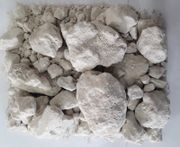Difference between pages "Balfour granite" and "Ball clay"
| Line 1: | Line 1: | ||
| + | [[File:Ball clay.jpg|thumb|Ball Clay]] | ||
== Description == | == Description == | ||
| − | A | + | A fine, soft, very plastic clay. Ball clay is a relatively pure, [[secondary clay]] composed of [[kaolin]] (20-90%), [[mica]] (5-45%), and [[quartz]] (1-70%). The high quality clay is found in England (Wareham, Dorset, Devon) and the U.S. (Kentucky, Tennessee). Originally, ball clay was dug up and made into 30-35 pound balls for transportation by horses. The fine-grain clay contains small amounts of carbon and other organic materials that give it an initial dark color. These materials are combusted during firing leaving a white vessel. Ball clay is very plastic and has a high shrinkage rate of up to 20 %. It is often mixed with other clays to increase their plasticity. Ball clay is used in the manufacture of ceramics, whiteware, porcelain, glass, and tiles. |
== Synonyms and Related Terms == | == Synonyms and Related Terms == | ||
| − | + | argile plastique (Fr.); argila gorda (Port.) | |
==Resources and Citations== | ==Resources and Citations== | ||
| − | * | + | * G.S.Brady, ''Materials Handbook'', McGraw-Hill Book Co., New York, 1971 Comment: p. 428 |
| − | * | + | * Ralph Mayer, ''A Dictionary of Art Terms and Techniques'', Harper and Row Publishers, New York, 1969 (also 1945 printing) |
| + | |||
| + | * Richard S. Lewis, ''Hawley's Condensed Chemical Dictionary'', Van Nostrand Reinhold, New York, 10th ed., 1993 | ||
| + | |||
| + | * Henry Hodges, ''Artifacts: An Introduction to Early Materials and Technology'', Ronald P. Frye, Kingston, Canada, 1988 | ||
| + | |||
| + | * Robert Fournier, ''Illustrated Dictionary of Practical Pottery'', Chilton Book Company, Radnor, PA, 1992 | ||
| + | |||
| + | * Random House, ''Webster's Encyclopedic Unabridged Dictionary of the English Language'', Grammercy Book, New York, 1997 | ||
| + | |||
| + | * ''The Dictionary of Art'', Grove's Dictionaries Inc., New York, 1996 Comment: "Ceramics" | ||
| + | |||
| + | * Art and Architecture Thesaurus Online, http://www.getty.edu/research/tools/vocabulary/aat/, J. Paul Getty Trust, Los Angeles, 2000 | ||
[[Category:Materials database]] | [[Category:Materials database]] | ||
Latest revision as of 16:44, 1 May 2022
Description
A fine, soft, very plastic clay. Ball clay is a relatively pure, Secondary clay composed of Kaolin (20-90%), Mica (5-45%), and Quartz (1-70%). The high quality clay is found in England (Wareham, Dorset, Devon) and the U.S. (Kentucky, Tennessee). Originally, ball clay was dug up and made into 30-35 pound balls for transportation by horses. The fine-grain clay contains small amounts of carbon and other organic materials that give it an initial dark color. These materials are combusted during firing leaving a white vessel. Ball clay is very plastic and has a high shrinkage rate of up to 20 %. It is often mixed with other clays to increase their plasticity. Ball clay is used in the manufacture of ceramics, whiteware, porcelain, glass, and tiles.
Synonyms and Related Terms
argile plastique (Fr.); argila gorda (Port.)
Resources and Citations
- G.S.Brady, Materials Handbook, McGraw-Hill Book Co., New York, 1971 Comment: p. 428
- Ralph Mayer, A Dictionary of Art Terms and Techniques, Harper and Row Publishers, New York, 1969 (also 1945 printing)
- Richard S. Lewis, Hawley's Condensed Chemical Dictionary, Van Nostrand Reinhold, New York, 10th ed., 1993
- Henry Hodges, Artifacts: An Introduction to Early Materials and Technology, Ronald P. Frye, Kingston, Canada, 1988
- Robert Fournier, Illustrated Dictionary of Practical Pottery, Chilton Book Company, Radnor, PA, 1992
- Random House, Webster's Encyclopedic Unabridged Dictionary of the English Language, Grammercy Book, New York, 1997
- The Dictionary of Art, Grove's Dictionaries Inc., New York, 1996 Comment: "Ceramics"
- Art and Architecture Thesaurus Online, http://www.getty.edu/research/tools/vocabulary/aat/, J. Paul Getty Trust, Los Angeles, 2000
